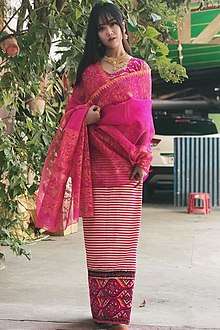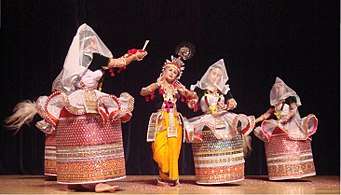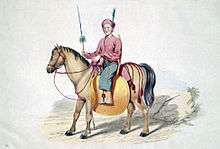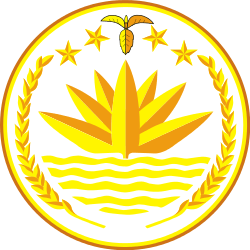Meitei people
The Meitei people are an ethnic group that comprise the majority in Manipur, a northeastern state of India.[2] The Meitei primarily settled on a large valley in modern-day Manipur, although a sizable diaspora have settled in Assam,[3] Meghalaya.[4] Tripura, Nagaland, Bangladesh and Burma( Myanmar). The Meitei ethnic group represents about 53% of Manipur's population.[5]
 A Meitei woman in traditional attire | |
| Total population | |
|---|---|
| 1.8 million+ (2011) | |
| Regions with significant populations | |
| India | 1,761,079 [1] |
| Manipur | 1,522,132 |
| Assam | 168,133 |
| Tripura | 23,779 |
| Nagaland | 9,511 |
| Meghalaya | 4,451 |
| Bangladesh | 39,000 approx |
| Myanmar | 25,000 approx |
| Languages | |
| Meitei language | |
| Religion | |
| Related ethnic groups | |
| Nagas, Kukis, Zomis, Tangkhul, Angami, Burmese, Shan | |
Endonyms and exonyms
The Meitei are known by a number of endonyms, Meitei, Meetei (ꯃꯤꯇꯩ), Meithei (ꯃꯩꯊꯩ), and as well as by numerous exonyms, including Manipuri (ꯃꯅꯤꯄꯨꯔꯤ), Cassay-Shan (ꯀꯦꯁꯤ-ꯁꯥꯟ), and Kathe (Burmese: ကသည်း). The etymological origins of the word "Meitei" are contested; the term may have descended from the word "Mitei," which means "modeled in god's image."[6]
Origins
The origins of the Meitei people are not conclusively known. What is known that their settlement on a fertile plain and valley regions of the Imphal River and the tributaries of the Manipur River enabled the Meitei to develop sophisticated wet rice cultivation systems, which supported a denser population and drove the development of a more complex political and social system than in adjacent hill areas.[7]
According to the royal chronicle, Cheitharol Kumbaba, the Manipuri valley was ruled by 9 different clans or tribes, which later merged into seven.[8] Between the 1st and 10th centuries, the tribes consolidated under a feudal system over time, owing to the military prowess of the Mangang or Ningthouja tribe.[8] During this process, neighboring hill tribes were also absorbed into the seven clans through migration, a process that continued well into the 1800s.[8]
The Meiteis are East Asian, but they also have some Indo-European admixture.[9] Sir James Johnstone, who was the political agent in Manipur, writes: "The Manipuris themselves are a fine stalwart race descended from an Indo-Chinese stock, with some mixture of Aryan blood, derived from the successive waves of Aryan invaders that have passed through the valley in pre-historic days".[10]. Jhalajit Singh believes Indo-Aryans came to Manipur and married local women in the first centuries of the common era (CE).[11]. Scholars and writers, such as E. Dun (1992), Hodson (1908, 2), and M. Bhattarcharya (1963, 183) also support the tradition that the Meiteis were originally East Asian, a close kin with the tribal people in the hills, and later intermarried with Indo-European people.In 14 the century , Kakpa Thawanthaba married a Westerner princess from beyond the border of Manipur who came with 10 attendants to settle permanently in Manipur. The 10 attendants assimilated in one or other of seven clans of the Meiteis. A carefully conducted scrutiny of the names of her attendants reveals that they were Aryans. The immigration of Westerners is recorded in the book named "Nong Chup Haram"
The people from the East came to Manipur in different periods of History. They were Shans, a little of the Chines and the Burmese. There were some immigrants from the Upper Burma in the reign of Nongta Lauren Pakhangba ( 1st century), Naoting Khong (7 th century) and King Khunmomba ( 13 th century) and they became Meiteis. In the reigns of Ningthou-Khomba, Kyamba and Ming Yamba, some of fresh immigrants also became Meiteis. But after reign of King Khangemba(1597-1652) there were little immigration from the East.
The earliest written record of their existence dates back to 1445 CE, during the kingdom of Kangleipak.[12]
With the Meitei kingdom's expansion westward (beyond the Chindwin River by the 1400s) came increased interaction and conflict with the Tai-speaking Shans and Burmans.[13] The Meitei conquest of the Kabaw valley accelerated the establishment of social and trade relationships between the Burmans and the Meitei, including matrimonial alliances between the royal houses.[13] The Meitei however, remained a staunch constant threat to security, with constant raids and battles fought close to the Burmese royal capitals.[13]
The Burmese Toungoo dynasty was endangered by frequent invasions under Garib Niwaz.[14] However, the Burmese underwent a military renaissance in the latter half of the 1700s, with the rise of Alaungpaya's Konbaung dynasty, which ended this persistent pattern of Meitei raids, through devastating defensive military campaigns waged on the Meitei kingdom, which led to the demise of the Meitei monarchy; Burmese interference in Manipur came to an end with the First Anglo-Burmese War, in which the Burmese ceded complete control of Manipur to the British
Language
The Meitei people speak Meiteilon (also known as Manipuri), a Tibeto-Burman language. Meiteilon is one of the officially recognized languages of India, and was included in the Eighth Schedule to the Constitution of India in 1992.[16]
Historically, Meitei was written in an indigenous Meitei Mayek script;[17] the script was replaced by the Bengali script in the early 18th century.[18] The Meitei Mayek script has seen a revival in recent decades, and is now seen in street signs, newspapers, literature, and legislative proceeding records.[19]
Some of the most notable Meitei historical literary works, written by court scholars, include:
- Cheitharol Kumbaba, the royal chronicle of Meitei kings
- Wakoklon Heelel Thilen Salai Amailon Pukok Puya, the oldest extant Meitei manuscript, first written in 1400 CE and rediscovered in 1971
- Puya (Meitei texts), preserved manuscripts (lit. meaning "advices and orders from the elders")
Kinship system
The Meitei people are made up of seven major clans, known as Salai Taret.[20] The clans include Mangang, Luwang, Khuman, Angom, Moirang, Khaba-Nganba and (Chenglei) Sarang-Leishangthem.
Meiteis reckon kinship through both affinal and consanguineal relationships. The Meitei word for "kin" is mari mata and the relationship mari-mata thoknaba literally means "to have relationship". Schematically, there are two types of kinship: luhonglaga thok naba mari (affinal relation) and ee-gi mari leinaba (consanguineal relation).
Meitei kinship is classified at three levels: by clan or kin (yek-salai), by lineage (sagei) and by family (imung manung). Under each of the 7 Meitei clans exists many sageis.
The kinship terms in Meitei are unilineal, patrilineal and patrilocal. Meitei kinship terms are classificatory with an exception of some descriptive terms. There are only four descriptive kin terms in Meiteilon:
- ima ‘mother’
- ipa ‘father’
- iku/ikubok ‘father-in-law’
- inem/inembok ‘mother-in-law’
Calendar
The Meitei follow a traditional calendar called Maliyafam Palcha Kumsing, which has 12 months and a 7-day week, like the Gregorian calendar.[21]
Culture

Most of the rich culture of Manipur can be credited to the Meiteis. Since ancient times the valley region of Manipur was trading crossroads between India and Myanmar and gradually the valley portion of Manipur became the melting pot of Indo-Burman culture. The famous Manipuri dance form had its roots from the Lai Haraoba dance form.
They are also known for their contribution to art, literature and cinema. M.K. Binodini Devi, Khwairakpam Chaoba Singh, Ratan Thiyam, Aribam Syam Sharma, Rajkumar Shitaljit Singh, Elangbam Nilakanta Singh, Heisnam Kanhailal and Sabitri Heisnam are some of the prominent personalities in the field.
The Meitei people are very fond of horse riding.
Art
The Manipuri martial art Thang-ta is a combative sport which had its origin from the Meitei knights during the kings rule. It involves various fighting techniques with swords and spears.
Religion and festivals
According to the 2011 census, Meiteis follow only two religions, with overwhelming majority of Meiteis practicing variants of Hinduism. Around 14% of Meiteis traditionally believe in Sanamahi religion named after god Sanamahi. Meiteis follow both Hindu as well as Sanamahi religious traditions and rituals. For example, they worship Sanamahi in the south-west corners of their homes.[22] The various types of festivals that are the most significant, and are celebrated with great joy by meiteis are Rasalila, Janmastami, Holi, Lai Haraoba, Cheiraoba, Yaosang, Ratha Yatra|Jagannath Rath Yatra]], Holi, Diwali, Ram Navami etc.
Cuisine
Rice, vegetables and fish are staple food of the Meiteis. Rice is accompanied by a one or several sides. The vegetables are either made as stews (Kangsoi) with less oil used in sauteing, or stir fried directly in oil and many spices to make an oily spicy side dish (Kanghou). Roasted dried fish or fried fresh fish is usually added in most of the stews and curry to impart special taste. The vegetables, herbs and fruits consumed in the region are more similar to those in Southeast/East/Central Asian, Siberian, Polynesian and Micronesian cuisines such as Myanmar, Thailand, etc. E.g. treebean (youngchaak), galangal (loklei), culantro (awa phadigom), lime basil (mayangton), fishwort (toningkhok) and many others, which are not cultivated in northern India. One of the most important ingredients in Meitei cooking is Ngari (fermented fish). Roasted ngari is used in the singju (a kind of salad), morok metpa (chilli chutney), iromba (boiled and mashed veggies with chillies). A variety of fermented bamboo shoots (soibum) as well as fresh bamboo shoots, and fermented soya beans (hawaijaar) also form an important of Meitei cuisine. All meals are served with some fresh aromatic herbs on the side. A typical every day Meitei meal will have rice, vegetable or fish curry, a piquant side dish (either morok metpa or iromba accompanied with herbs), a champhut (a sweet vegetable, eg, carrot, pumpkin or cucumber slices just steamed or boiled with a little sugar), and a Kanghou.
Clothing
Meitei women wear Phanek which is a kind of Sarong but has a unique style. They are either horizontal stripe pattern which is called Phanek mayeknaibi or single block colour. The ends are decorated with high embroidery. It is usually accompanied by a blouse and a matching enaphi which is like a Dupatta but usually transparent.
Subsistence
The Meitei are mainly agriculturists in which rice is a staple crop. However, they also grow mangoes, lemons, pineapples, oranges, guavas, and other fruits. Fishing is also common among the Meitei that can either be a profession or a hobby. Women tend to dominate the local markets as sellers of food items, textiles, and traditional clothing.[23]
Sports
Ancient sports are still in existence while some got extinct, a few got spread throughout the world.
Some sports are worth mentioned as follows
- Sagol Kangjei: It is the earliest form of modern-day Polo which traces its origin to Manipur. According to Guinness World Records (1992), " Polo can be traced to origins in Manipur state, India, C. 3100 CE when it was played as 'Sagol Kangjei' ".
- Mukna Kang-jei: It is a form of Meitei Wrestling. It is considered to be the most masculine form of sports.
- Khong kangjei: It is a form of Meitei Hockey.
They introduced polo to the west when the British came to Manipur valley during the kings rule. It is locally called Sagol Kangjei. It is believed that the game was played by the Gods of Meiteis as a practice of warfare. According to Chaitharol-Kumbaba, a Royal Chronicle of Manipur King Kangba who ruled Manipur much earlier than Nongda Lairen Pakhangba (33 AD) introduced Polo.
Kang Sanaba is a game played under a shed of building on an earth ground (court) smoothly levelled to suit the course of the 'Kang' the target on the court. It is well marked for the respective positions of the players of both to hit the target on the court. It has rules and regulations formed by the associations to suit the occasions of the games either for competitive tournaments or friendly entertainment. The dignitaries of the Palace, even Queen and King also participated on social functions.
Mukna a unique form of wrestling popular amongst the Meiteis.
Mukna Kangjei also known as Khong Kangjei is a game which combines the arts of mukna (wrestling hockey) and Kangjei (Cane Stick) to play the ball made of seasoned bamboo roots.[3] The origin of the game dates to Aniconic worship. People celebrate Lai Haraoba (festival to please traditional deities) and include this item to mark the end of the festival. It was believed that Khagemba Ningthou (King, 1597–1652) patronised this game.
Yubi lakpi is a traditional full contact game played by Meiteis using a coconut, which has some notable similarities to rugby.[1] Yubi lakpi literally means "coconut snatching". The coconut is greased to make it slippery. There are rules of the game, as with all Manipur sports. It is played on the lush green turf. Each side has 7 players in a field with about 45x18 meters in area.[6] The goal post is 4.5x3 meters box in the central portion of the goal line. The coconut serves the purpose of a ball and is offered to the king, the chief guest or the judges before the game begins. The aim is to run while carrying the greased coconut and physically cross over the goal line, while the other team tackles and blocks any such attempt as well as tries to grab the coconut and score on its own.
Oolaobi (Woo-Laobi) is an outdoor game mainly played by females.[1] Meitei mythology believes that Umang Lai Heloi-Taret (seven deities–seven fairies) played this game on the Courtyard of the temple of Umang Lai Lairembi. The number of participants is not fixed but are divided into two groups (size as per agreement). Players are divided as into Raiders (Attackers) or Defenders (Avoiders).
The Raiders say "oo" without stopping as long as they can continue and try to touch the Avoiders. If a Raider touches an Avoider while saying "oo", the Avoider is out. This process goes on till all Avoiders are out or surrender. If a raider fails to say "oo" or is out of breath, the Raider is out. Points are counted on the elimination of Raiders/Defenders.
If Raiders are tired they declare for change and a time limit is decided on. The principles of Oolaobi are very similar to Kabaddi in India. The ground (court) is not marked; normally the open space in the premises of the house or temple is used for the game. Oolaobi, sometimes spelled Woolaobi, is very popular with girls and a source of talent in Kabaddi.
Heeyang Tanaba (Hi Yangba Tanaba) is a traditional boat rowing race[1] and festivity of the Panas. This is held during the month of November. This was introduced during the time of Ningthourel Khunjaoba, the second son of King Khagemba, who dug the Kangla Moat around the Palace to make it impregnable in the year of 1660 after he ascended the throne in 1652. In the traditional function two boats "Tanahi" (Race Boat) are detailed for leaders known as "Tengmai Lappa". In each boat forty Hiroys (Boatsman) operate the boat. The boat which reaches the finishing line is the winner and all boatsman raise their (Now) oars high in the air as a sign of reaching the finishing line first and thus the winner of the race is declared. The leader pays his respect to the deity and the King of Manipur.
Arambai Hunba People of Manipur are very fond of riding horses specially those who are in the village near the breeding areas. Since the ponies are easily available, the young boys get the chance of riding ponies without saddle on horse back. Sometimes they ride horse using a rope in place of regular bridle throwing branches of small trees in place of Arambai. This practice helped the Meitei Arambai force as a martial art which was very much required during the advance and withdrawal of forces. This art was very popular as an indigenous game of the Meitei youths.
Some outdoor games formerly played by children are nearly extinct. These include Khutlokpi, Phibul Thomba, Kanthali, and Chaphu Thugaibi.
Notable Meitei
Main Article: List of Meitei People
- Angom Gopi - Manipuri Writer, Poet of 18th Century
- A. Boby Singh - Professional bodybuilder, 12 times Mr. India title winner
- Bodhchandra Singh - Last Maharaja of Manipur State
- K. Himalay Singh - former Lieutenant General in Indian army
- Major Laishram Jyotin Singh - recipient of Ashok Chakra, India's highest peacetime military decoration
- M. Koireng Singh - 1st Chief Minister of Manipur, politician
- N. Biren Singh - Current Chief Minister of Manipur
- Rajkumar Ranjan Singh - Current Member of Parliament from Inner Manipur.
- Thounaojam Chaoba Singh - Former Union Minister of State, Culture, Youth Affairs and Sports
- Tikendrajit Singh - Revolutionary, Freedom Fighter, Commander of Manipur State Force.
Diaspora
Myanmar (Burma)

Myanmar is home to a sizable community of Meiteis, who are called Kathe in Burmese.[13] Unlike other Hindu communities in Myanmar, the Meitei resemble other Burmese ethnic groups in terms of physical appearance, which has accelerated their assimilation and integration into Burmese society.[13] In the early 1950s, Burmese Meiteis numbered approximately 40,000, with a third of them residing in Mandalay.[24] Current estimates are approximately 25,000.[25] Meiteis have resettled throughout the country, including in villages near Myitkyina to the north, Homalin, Kalewa, Pyay, in the center of the country, and Yangon to the south.[24] They continue to practice Hinduism in Myanmar.[26]
As a result of wars between Meitei kingdom and the Konbaung dynasty between the 17th and 18th centuries, many Meiteis were resettled in the Burmese kingdom.[8] Some Meitei settlements in modern-day Myanmar originate from the 1758–1759 war, and from the Burmese occupation of Manipur from 1819 to 1826.[8][24] Alaungpaya, during the former campaign, resettled Meiteis in Sagaing and Amarapura.[24] The Meitei people's horsemanship skills were employed in the Burmese royal army, where they formed the elite Cassay cavalry (ကသည်းမြင်းတပ်) and artillery regiments (ကသည်းအမြောက်တပ်) which were employed during the Burmese–Siamese wars.[14] The Burmese court also retained a retinue of Meitei Brahmins called Bamons, also called Kathe Ponna (ကသည်းပုဏ္ဏား) to advise and conduct court rituals.[24]
See also
- Ancient Meiteis
- Eromba
- List of Meitei kings
- Meira Paibi
- Ningthouja dynasty
- Pangal
- Sajibu Cheiraoba
- Singju
References
- "Census of India". Census India. MHA, Govt ofIndia.
- Prabaskar, Arunima. "Shiv Sena plans to rename Nagaland to Naganchi". Geocities.ws.
- "Meitei Diaspora In Assam". E-pao.net. Retrieved 30 September 2017.
- "Festivals in Meghalaya, Fairs and Festivals of Meghalaya". Travelhot.in. Retrieved 13 November 2018.
- Khomdan Singh Lisam, Encyclopaedia Of Manipur, ISBN 978-8178358642, pp. 322–347
- Tarapot, Phanjoubam (2003). Bleeding Manipur. Har-Anand Publications. ISBN 978-81-241-0902-1.
- LaPolla, Randy J.; Thurgood, Graham (17 May 2006). The Sino-Tibetan Languages. Routledge. ISBN 978-1-135-79717-1.
- Oinam, Bhagat (2005). Murayama, Mayumi (ed.). "Manipur". Sub-Regional Relations in the Eastern South Asia: With Special Focus on India's North Eastern Region. 133.
- (Hodson 1908)
- (Johnstone 1896, 97)
- "As a result of the fusion of Indo-Aryans and [East Asian] peoples, the nucleus of the Manipuri speaking people (Meiteis) of today was formed" (Singh 1992, 19-20)
- "A Brief History of the Meiteis of Manipur". The Manipur Page. P. Lalit. Retrieved 30 September 2017.
- Nongthombam, Jiten (1 July 2011). "The Meitei Diaspora in Myanmar". Diaspora Studies. 4 (2): 155–167. doi:10.1080/09739572.2011.10597359. ISSN 0973-9572.
- Singha, Memchaton (2016). "MARRIAGE DIPLOMACY BETWEEN THE STATES OF MANIPUR AND BURMA, 18TH TO 19TH CENTURIES". Proceedings of the Indian History Congress. 77: 874–879. doi:10.2307/26552717. ISSN 2249-1937.
- "Archived copy" (PDF). Archived from the original (PDF) on 19 February 2014. Retrieved 18 June 2014.CS1 maint: archived copy as title (link)
- "Eight Schedule of the Constitution of India" (PDF). Mha.nic.in. Archived from the original (PDF) on 5 March 2016. Retrieved 30 September 2017.
- "History of Meetei Mayek". Tabish.freeshell.org. Retrieved 30 September 2017.
- "Manipuri language and alphabets". Omniglot.com. Retrieved 30 September 2017.
- Laithangbam, Iboyaima (23 September 2017). "Banished Manipuri script stages a comeback". The Hindu. ISSN 0971-751X. Retrieved 25 May 2020.
- "Origin of the Meiteis Part 2". E-Pao. Dr J Rimai.
- "Names of 12 months of Kangleipak concepts and significances". e-pao.net. Retrieved 25 May 2020.
- "'Inclusion of Sanamahi religion in minority is being reviewed' : 27th aug11 ~ E-Pao! Headlines". www.e-pao.net. Retrieved 25 May 2020.
- Winston, Robert, ed. (2004). Human: The Definitive Visual Guide. New York: Dorling Kindersley. p. 441. ISBN 0-7566-0520-2.
- Sanajaoba, Naorem (1988). Manipur, Past and Present: The Heritage and Ordeals of a Civilization. Mittal Publications. ISBN 978-81-7099-853-2.
- Sunil, Oinam; 2015-07-14. "Manipuris in Mandalay see ray of hope in Modi". The Times of India. Retrieved 25 May 2020.CS1 maint: numeric names: authors list (link)
- "စစ်ကိုင်းမြို့တွင် ကသည်းမယ်တော်ကြီးချိုးရေတော်သုံးပွဲကျင်းပ". Eleven Broadcasting. 13 June 2019.
Further reading
- Kshetrimayum, Otojit. (2014). Ritual, politics and power in north east India: Contexualising the Lai Haraoba of Manipur. New Delhi: Ruby Press & Co.
- Singh, Saikhom Gopal. (2014). The Meeteis of Manipur: A study in human geography. New Delhi: Ruby Press & Co.
- Singh, Saikhom Gopal. (2014). Population geography of Manipur. New Delhi: Ruby Press & Co.
